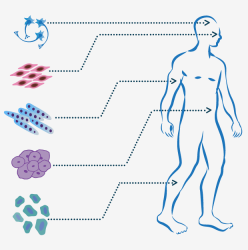In January 2016, Prime Minister Justin Trudeau announced that $20 million from the Advanced Manufacturing Fund will be given to the Centre for
Commercialization of Regenerative Medicine (CCRM)
[1]. The money will go toward the operation of the Centre for Advanced Therapeutic Cell Technologies in Toronto. Cell therapy development could lead to further progress in regenerative medicine as well as treatments for several different health problems.

Regenerative medicine focuses on using stem cells and the body’s own regenerative capability to restore function to damaged cells, tissues, and organs. Advances in regenerative medicine would serve as a benefit to doctors in Ontario and could rapidly improve patients’ quality of life. Researchers at
The Ontario Institute for Regenerative Medicine (OIRM) are working to find treatments for those who have suffered
visual impairment, a heart attack, brain and/or spinal cord injury, or
septic shock.
Visual Impairment
Age-related macular degeneration (AMD) is the most common cause of blindness. There is currently no treatment for AMD, and doctors can only suggest vitamins and supplements that could possibly slow its progression
[2]. However, researchers at the OIRM are testing
stem cell methods that could possibly restore sight. In other words, doctors could be offering treatment for patients who have lost their vision because of AMD that would allow them to see again. Researchers are also considering treatment that could reverse limbal stem cell deficiency, or tissue deficiency in the layer on top of the cornea.
Heart Attack
When a patient suffers a heart attack, scar tissue is naturally formed in place of damaged heart muscle. There are currently only limited options for treatment, and progressive heart failure can follow. If researchers are successful, doctors could soon be able to offer a treatment that includes transplanting heart muscle cells to regenerate areas that have been damaged because of the patient’s heart attack.

Brain Injury
Some injuries can cause damage to white brain matter, and this can result in permanent cognitive problems or disorders like multiple sclerosis. Researchers are working toward using brain stem cells to generate the same cells found in white brain matter (oligodendrocytes). If this research is successful, the effects of brain injury could be reversible as repairing damaged white matter would be possible.
Spinal Cord Injury
Spinal cord injuries (SCIs) could result in paralysis and is currently irreversible. Treatments for SCIs are challenging because it is difficult for doctors and surgeons to work on an injured spinal cord, and stem cells usually die after they are transplanted. Researchers at OIRM are testing bioengineered interventions that overcome the inhibitory environment of an injured spinal cord, and stem cells that can survive post-transplant.
Septic Shock
Septic shock is the most severe form of infection. Right now, the only treatment is administering fluids and antibiotics, but nearly half of patients will die or suffer from long-term physical dysfunction. The OIRM is conducting the world’s first “
Cellular Immunotherapy for Septic Shock” clinical trial, and doctors could use this as a treatment in the future.
Cellular immunotherapy will use an optimal dose of mesenchymal stem cells to treat patients with septic shock, and this could save lives or dramatically improve quality of life by reversing debilitating physical ailments caused by septic shock.
The funding that has been provided for the Centre for Advanced Therapeutic Cell Technologies in Toronto could contribute to revolutionary discoveries in regenerative medicine. Therapies that are currently being investigated could change the lives of doctors and patients not only in Ontario, but across the world.

 Regenerative medicine focuses on using stem cells and the body’s own regenerative capability to restore function to damaged cells, tissues, and organs. Advances in regenerative medicine would serve as a benefit to doctors in Ontario and could rapidly improve patients’ quality of life. Researchers at The Ontario Institute for Regenerative Medicine (OIRM) are working to find treatments for those who have suffered visual impairment, a heart attack, brain and/or spinal cord injury, or septic shock.
Regenerative medicine focuses on using stem cells and the body’s own regenerative capability to restore function to damaged cells, tissues, and organs. Advances in regenerative medicine would serve as a benefit to doctors in Ontario and could rapidly improve patients’ quality of life. Researchers at The Ontario Institute for Regenerative Medicine (OIRM) are working to find treatments for those who have suffered visual impairment, a heart attack, brain and/or spinal cord injury, or septic shock.
